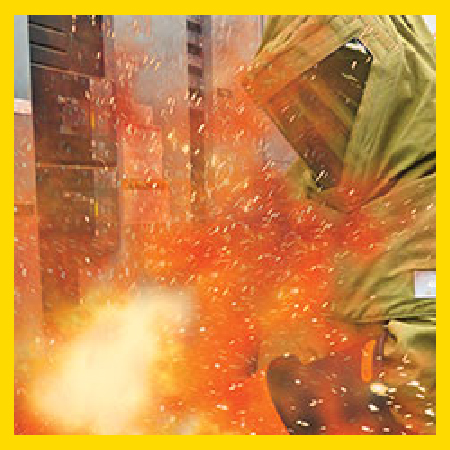Currency
November 10, 2018

In an industry where regulatory compliance is critical and in which the ultimate goal is the delivery of optimal patient care, electricity plays a critical role in providing always-on operation to help facilitate this care. In this environment, which already operates in a life-or-death mindset, arc flash prevention is imperative, and worker and personnel safety are of paramount importance.
The need to ensure arc flash safety has a significant impact on health care facilities, whether it's hospitals or any other environment where patient care is prioritized. Yet many health care providers struggle with how to best address this issue. In an era of constantly evolving codes and standards, doing so has never been more urgent.
In this article, I'll offer best practices for health care providers to make their facilities safer by protecting against arc flash hazards. Additionally, I’ll discuss new technologies that have emerged to help prevent against arc flash hazards and should be considered for any health care provider looking to enhance its arc flash prevention efforts.
Before diving into some available solutions for preventing arc flash safety in health care, it's important to review just how and why arc flashes can occur in these or any environments.
An arc flash is the explosive energy released when an electrical fault—a short circuit, for instance—causes an arc. This is measured in terms of arc flash incident energy and typically happens when an electric current passes through air as the result of a conductor failure, equipment failure, or the accidental connection between voltage sources such as dropping a tool across buses in distribution equipment.
The explosive energy resulting from an arc flash can be deadly or cause severe injury. The incident energy generated from an arc flash can release temperatures in excess of 36,000 degrees Fahrenheit, which is four times hotter than the sun. Any metals vaporized by the explosion (e.g., copper, aluminum) would also be fatal if inhaled.
The danger of arc flash events is particularly common in power-intensive environments and industries—particularly ones operating with 125 kVA or larger transformers—and health care certainly qualifies. Many health care facilities, especially large hospital campuses, have adopted their own grid systems or microgrids, creating a greater need for arc flash prevention, particularly for personnel tasked with working in these grid environments.
The dangers of arc flash events in health care are amplified, however, by the possibility for downtime resulting from arc flashes. As we've established, health care facilities require always-on power to maximize patient care, and this is literally a life-and-death imperative. Downtime in the health care environment is simply not acceptable.

While arc flash events pose serious risk to health care personnel, these incidents are preventable, and risk can be minimized.
One of the best ways to avoid electrical disasters is to increase the time and distance from arc to the worker, as these are two of the most controllable variables. Reducing the time that an event persists by tripping a breaker or blowing a fuse significantly reduces the arc flash incident energy. Additionally, leveraging remote operation, closed doors, or protective barriers protects workers in case an event occurs by increasing the distance between the arc and the worker.
Another way health care facilities can improve arc flash safety is through better labeling. Arc flash labels indicate two key pieces of information: the expected incident energy (measured in calories per cm2)—at a working distance of 18 inches or 24 inches—which drives the proper personnel protective equipment (PPE) required for protection; and the distance a worker without PPE must work to avoid a non-curable burn (typically measured in feet). By using correct labeling on critical equipment, facilities can get ahead of potential safety issues to ensure personnel are protected.
The need to ensure arc flash safety has a significant impact on health care facilities, whether it's hospitals or any other environment where patient care is prioritized. Yet many health care providers struggle with how to best address this issue. In an era of constantly evolving codes and standards, doing so has never been more urgent.
In this article, I'll offer best practices for health care providers to make their facilities safer by protecting against arc flash hazards. Additionally, I’ll discuss new technologies that have emerged to help prevent against arc flash hazards and should be considered for any health care provider looking to enhance its arc flash prevention efforts.
Refresher: Why Arc Flash Safety Matters for Health Care
Before diving into some available solutions for preventing arc flash safety in health care, it's important to review just how and why arc flashes can occur in these or any environments.
An arc flash is the explosive energy released when an electrical fault—a short circuit, for instance—causes an arc. This is measured in terms of arc flash incident energy and typically happens when an electric current passes through air as the result of a conductor failure, equipment failure, or the accidental connection between voltage sources such as dropping a tool across buses in distribution equipment.
The explosive energy resulting from an arc flash can be deadly or cause severe injury. The incident energy generated from an arc flash can release temperatures in excess of 36,000 degrees Fahrenheit, which is four times hotter than the sun. Any metals vaporized by the explosion (e.g., copper, aluminum) would also be fatal if inhaled.
The danger of arc flash events is particularly common in power-intensive environments and industries—particularly ones operating with 125 kVA or larger transformers—and health care certainly qualifies. Many health care facilities, especially large hospital campuses, have adopted their own grid systems or microgrids, creating a greater need for arc flash prevention, particularly for personnel tasked with working in these grid environments.
The dangers of arc flash events in health care are amplified, however, by the possibility for downtime resulting from arc flashes. As we've established, health care facilities require always-on power to maximize patient care, and this is literally a life-and-death imperative. Downtime in the health care environment is simply not acceptable.

Best Practices for Arc Flash Safety in Health Care Environments
While arc flash events pose serious risk to health care personnel, these incidents are preventable, and risk can be minimized.
One of the best ways to avoid electrical disasters is to increase the time and distance from arc to the worker, as these are two of the most controllable variables. Reducing the time that an event persists by tripping a breaker or blowing a fuse significantly reduces the arc flash incident energy. Additionally, leveraging remote operation, closed doors, or protective barriers protects workers in case an event occurs by increasing the distance between the arc and the worker.
Another way health care facilities can improve arc flash safety is through better labeling. Arc flash labels indicate two key pieces of information: the expected incident energy (measured in calories per cm2)—at a working distance of 18 inches or 24 inches—which drives the proper personnel protective equipment (PPE) required for protection; and the distance a worker without PPE must work to avoid a non-curable burn (typically measured in feet). By using correct labeling on critical equipment, facilities can get ahead of potential safety issues to ensure personnel are protected.









